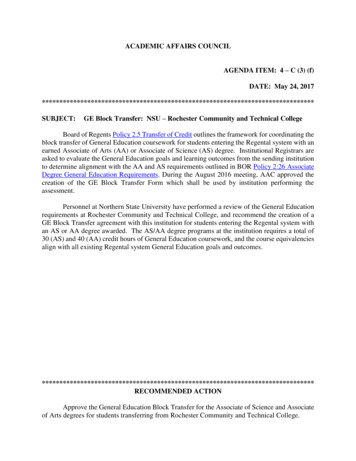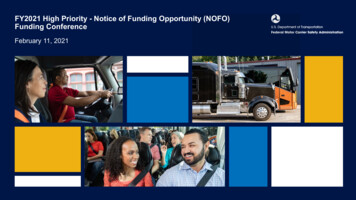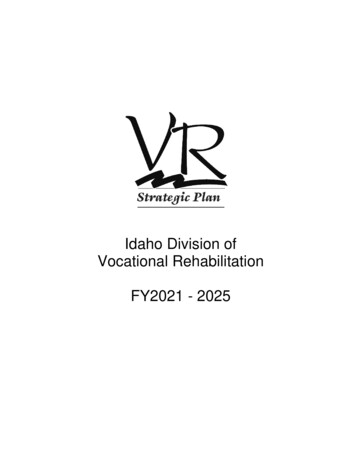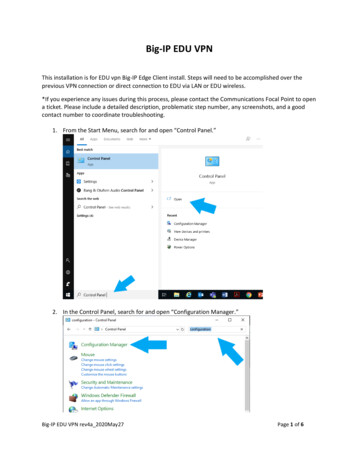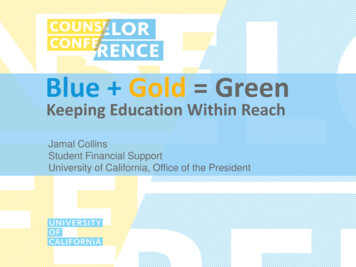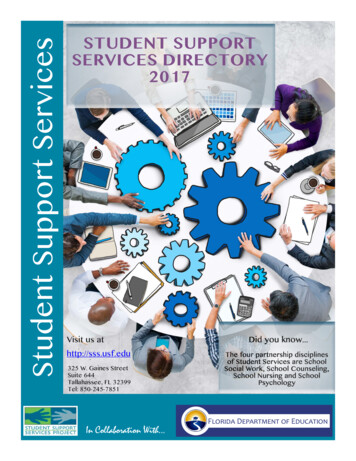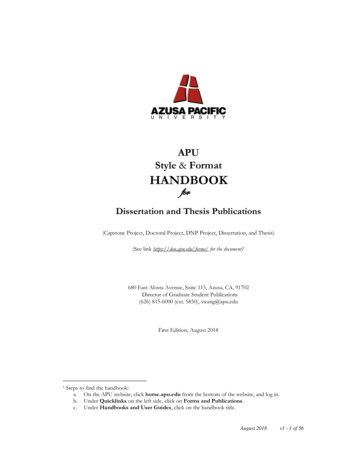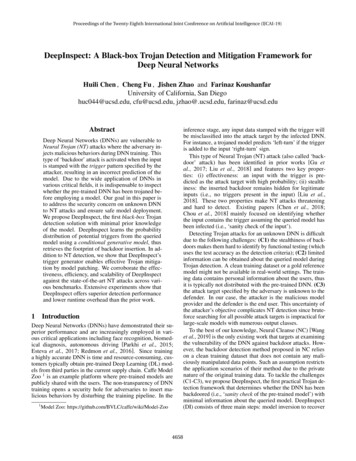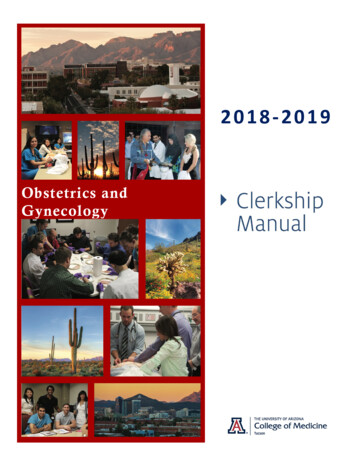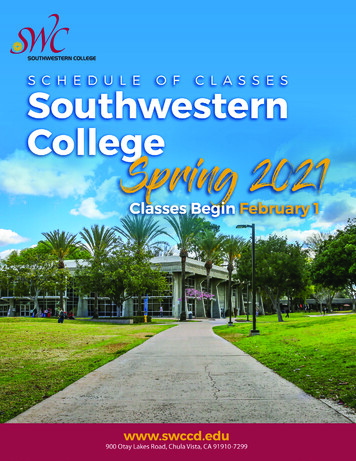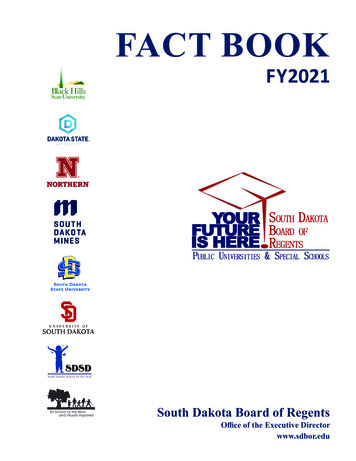
Transcription
FACT BOOKFY2021J;J;South Dakota School for the DeafSouth Dakota Board of RegentsOffice of the Executive Directorwww.sdbor.edu
A Note to Readers of the FY21 Fact BookThe COVID-19 pandemic presented uniquechallenges for South Dakota’s public universitiesand special schools. Our response to COVID-19required all institutions to adjust dynamically toan evolving public health challenge.Faculty, staff, administrators, and studentsadapted as many operational and instructionalchanges were implemented. Some classescontinued online or used a hybrid-learningmodel, offering a mix of virtual and in-personlearning. Special schools also quickly adjustedto meet students’ needs in new ways. A guidingprinciple remained – to ensure that studentscomplete their degrees or stay on track forgraduation.As a result, some data points presented in thisFY21 Fact Book may look quite different frominformation routinely reported in previous FactBook publications. We encourage readers toreview these data carefully, with the caveat thatFY21 was a year unlike any in the history ofpublic higher and K-12 education.
South Dakota Board of Regents Fact BookFiscal Year 2021Board Member Biographies . 2Instituutional Profilees. 4Student SuccessMinimum Admission Requirements . 11Historical Fall Headcount, Full-Time Equivalent, and Total Enrollments . 12Student Profile by University . 14High School Dual Credit. 15SD High School Graduates and University System Enrollment / High School Students Enrolled in University Courses . 16Distance Education . 17ACT - American College Testing: SD Distributions, SD Mean Scores by Completion of Core. 18Educational Improvement . 19New Undergraduate Registrants / Transfer Enrollments . 20Retention of New Degree-Seeking Undergraduates / Completion of Baccalaureate Degrees . 21Academic Quality & PerformanceAwarded Degrees and Baccalaureate Majors Awarded. 22Graduates - Teacher Education Majors . 25Graduate Trends Summary . 26Licensure and Certification Examinations . 27Placement Outcomes of Regental Graduates . 28In-State Placement of Regental Teacher Education Graduates . 29Student-Faculty Ratio / Employee Utilization / Average Salaries by Professional Rank . 30Faculty Profile by University . 31Research & Economic DevelopmentGovernor’s Research Center Program . 32Research Centers’ Economic Impact/ Grants and Contracts / FY20 Expenditures from Grants and Contracts. 33Grant and Contract Award History / Grant and Contract Expenditures History / System Technology Transfer . 34Affordability & AccountabilityFY21 Tuition and Fees Schedule . 35Regional Comparison Tuition and Fees . 42Regional Comparison Total Cost . 43Student Success Initiatives . 44South Dakota Opportunity Scholarship / Student Financial Aid by Program . 45Total Financial Aid from Loans / Average Student Loan Debt / Loan Default Rates. 46Board of Regents Percent of General Fund Expenditures / Board of Regents All Funds by Funds Source. 47History of General Fund Appropriations . 48All Funds Operating Budget . 50Operating Budgets by Program. 52Budgeted Salaries / FTE by Category (All Funds / General Funds). 56Actual Expenditures Per Student FTE / Student to General Fund Support . 58Appropriations / Education Appropriations per FTE . 59Maintenance and Repair Goal / Buildings – Initial & Replacement Costs . 60Size of Physical Plant . 61Campus Housing Utilization . 62Campus Housing Utilization History / Campus Funded South Dakota Building Authority Leases . 63Auxiliary System Debt. 64South Dakota Building Authority HEFF Supported Leases . 65Special SchoolsSouth Dakota School for the Blind and Visually Impaired / South Dakota School for the Deaf . 66SDSBVI and SDSD Enrollment . 67
Fiscal Year 2021Board Member BiographiesSouth Dakota Board of RegentsJohn W. Bastian, President, Belle Fourche, holds a bachelor’s degree in political science fromSouth Dakota State University and a J.D. degree from Hamline University School of Law. He wasa circuit court judge for the Fourth Judicial Circuit for 20 years and retired in 2013. Prior to thatservice, he spent 10 years in the attorney general’s office as an appellate attorney and prosecutor.Bastian is also a veteran of the United States Air Force. He serves part-time with the South DakotaUnified Judicial System and is assigned to preside over cases in the Fourth, Sixth and Seventh JudicialCircuits. Appointed by Governor Daugaard in 2014 to complete the term of the late Randy Morris,his second term will expire in 2022.Jim Morgan, Vice President, Brookings, retired in 2013 after 12 years as president and CEO ofDaktronics, concluding a four-decade career at the Brookings-based electronics manufacturer, whichis the world’s industry leader in designing and manufacturing electronic scoreboards, programmabledisplay systems, and large-screen video displays. He joined Daktronics in the company’s first yearof operation as its first design engineer, while still a college student. He remains on the company’sboard of directors. Morgan is a graduate of South Dakota State University, where he earned both hisB.S. and M.S. degrees in electrical engineering. Appointed by Governor Daugaard in 2015, his termwill expire in 2021.Pam Roberts, Secretary, Pierre, holds a bachelor’s degree in commercial economics from SouthDakota State University. She retired in 2013 after a career in senior leadership roles, including Secretaryof Labor, Commissioner of Personnel, and Chief of Operations, in the administrations of governorsJanklow, Mickelson, Miller, Rounds, and Daugaard. Roberts and her husband, Clay, operate theirfamily’s ranch in Stanley and Lyman counties. Appointed by Governor Daugaard in 2016, her termwill expire in 2022.Brock Brown, Lake Norden, is enrolled in undergraduate studies in the history education programat South Dakota State University, which he plans to complete in May 2022. After graduation, Brownplans to become a high school teacher in South Dakota. Brown first became involved at SDSU throughresidence hall government, then became president of the Residence Hall Association, and later aStudents’ Association senator. Appointed by Governor Noem in 2020, his term will expire in 2022.Kevin Schieffer, Sioux Falls, holds a bachelor’s degree from the University of South Dakota and isa graduate of Georgetown University School of Law, where he also served as an adjunct professor oflaw. He is a business consultant in Sioux Falls and retired in 2008 after 12 years as chief executiveofficer of Cedar American Rail Holdings Inc., the largest regional railroad system in the U.S. Hewas appointed as United States attorney for South Dakota by President George H.W. Bush in 1991.He has engaged in the private practice of law and served as chief of staff to former U.S. Sen. LarryPressler from 1982 to 1991. Appointed by Governor Daugaard in 2013, his term will expire in 2021.2
Board Member BiographiesFiscal Year 2021Randy Schaefer, Madison, is a past president of the Board of Regents. He is a 1984 Dakota StateUniversity graduate with a bachelor’s degree in education. He is a State Farm Insurance agentin Madison where he has achieved many accomplishments, including Agency Masters Club andChairman’s Circle. He is an active member of Madison’s Chamber of Commerce and the Lake AreaDevelopment Association. Schaefer currently serves on the DSU Foundation Board of Trustees andis active in supporting local and area schools and their students. Appointed by Governor Rounds in2009, his term will expire in 2021.Joan Wink, Howes, holds a Ph.D. in curriculum and instruction from Texas A&M University, 1991;two masters’ degrees from the University of Arizona (Spanish, 1981; Educational Foundations/Bilingual, 1985); and a Spanish and English undergraduate degree from Yankton College, 1966.She is a professor emerita of California State University, Stanislaus. Since retirement in 2007, shehas been an adjunct professor at Black Hills State University, South Dakota State University, andin the Global Education Masters Program of The College of New Jersey in Mallorca, Spain. Sheretired from these positions in spring 2017. Appointed by Governor Daugaard in 2017, her termwill expire in 2023.Jim Thares, Aberdeen, is the founder and CEO of Primrose Retirement Communities, an Aberdeencompany founded in 1989 that currently operates 35 senior living communities in 16 states. Hehas also worked in hotel development and as a certified public accountant. Thares is a graduateof Moorhead State University, where he earned his degree in accounting. Appointed by GovernorDaugaard in 2017, his term will expire in 2023.Barb Stork, Dakota Dunes, founded and, from 1989 to 2016, served as CEO of Midwest ProvisionsInc., a multi-million-dollar contract food service company serving large corporations throughoutthe Midwest from South Dakota to Texas. She also served as chair of the Sanford Health SystemBoard of Trustees and is a past chairwoman of the Sioux Falls Area Chamber of Commerce. A nativeof Ute, Iowa, Stork earned a bachelor’s degree in business administration from West Texas A&MUniversity in Canyon, Texas. Appointed by Governor Noem in 2019, her term will expire in 2025.Brian Maher, Executive Director and CEO, Pierre, was appointed June 24, 2020, to lead SouthDakota’s six public universities and two special schools as the Board of Regents’ executive directorand chief executive officer. Dr. Maher’s experience in educational administration includes 21 yearsas a superintendent of K-12 school systems. He came to the Board of Regents after five years assuperintendent of the Sioux Falls School District, South Dakota’s largest public school district servingmore than 23,000 students. He was superintendent of schools in two Nebraska districts, Kearney andCentennial, from 1999 to 2015. A Nebraska native, he also worked as a school principal and beganhis career in education teaching mathematics, computer science, and physics. He was honored asNebraska’s superintendent of the year in 2015. He holds a doctorate in educational administrationfrom the University of Nebraska and a master’s degree, also in educational administration, from theUniversity of Nebraska at Omaha. His bachelor’s degree in mathematics education is from MidlandLutheran College (now Midland University) in Fremont, Neb.3
Fiscal Year 2021Institutional ProfilesBLACK HILLS STATE UNIVERSITYABOUT BHSUBlack Hills State University provides associate andSpearfishbaccalaureate degree programs in the liberal arts andsciences, education (SDCL 13-59-1), business, andtechnology. BHSU offers master’s degree programs ineducation, business services, and science. The BHSUCenter for Indian Studies (SDCL 13-59-2.1) provides opportunities to research andstudy the history, culture, and language of the Indians of North America and SouthDakota. BHSU supports the Center of Advancement in Mathematics and ScienceEducation.Laurie Nichols, PresidentTOP DISCIPLINES TOP 10 GRADUATING PROGRAMSEducation & RelatedBusiness RelatedPsychology and Social SciencesSTEM DisciplinesArts & Humanities1)2)3)4)5)6)7)8)9)10)Business Accounting & ManagementElementary EducationBiology/ Biological SciencesPsychologyGeneral StudiesExercise ScienceHuman ServicesMass Communications/Media StudiesCurriculum & InstructionSpecial EducationENROLLMENT*RETENTION RATEUNDERGRAD DEGREESGRAD DEGREES3,60865%49367Student ent3,413* Figures based upon Headcount42,5331,075
Institutional ProfilesFiscal Year 2021DAKOTA STATE UNIVERSITYABOUT DSUDakota State University provides 45 technology-centricdegrees in computer science, cyber operations, cyberMadisonsecurity, game design, cyber leadership & intelligence,business, data analytics, digital media, health analytics,math and science, and education. The educationprograms prepare elementary, secondary, and specialeducation teachers with expertise in the use of technology in teaching andlearning (SDCL 13-59-2.2). DSU also provides Ph.D. programs in Cyber Operations,Cyber Defense, Computer Science and Information Systems. In addition, DSUprovides master’s degrees in several cyber sciences and computer science, as wellas business, health information, and education technology. The National SecurityAgency and the U.S. Department of Homeland Security have designated DakotaState as Centers of Academic Excellence in cyber defense education, cyber defenseresearch, and cyber operations. Home to the Madison Cyber Labs, the universityhouses several cyber research institutes, the Center for the Advancement of HealthInformation Technology, the Center for Business Analytics & Research and the K-12Data Center.José-Marie Griffiths, PresidentTOP DISCIPLINES TOP 10 GRADUATING PROGRAMSSTEM DisciplinesSystem Health ProfessionsBusiness & RelatedEducation & RelatedHumanities & Related1)2)3)4)5)6)7)8)9)10)ENROLLMENT*RETENTION RATE3,18671%Computer ScienceCyber OperationsDigital Arts and DesignInformation SystemsAnalyticsNetwork & Security AdministrationCyber DefenseElementary Education / Special EducationComputer Game DesignHealth Information AdministrationUNDERGRAD DEGREESGRAD DEGREES420139Student 2,7401,3254461,861* Figures based upon Headcount5
Fiscal Year 2021Institutional ProfilesNORTHERN STATE UNIVERSITYABOUT NSUAberdeenNorthern State University provides associate andbaccalaureate degree programs in the liberal arts andsciences, education (SDCL 13-59-1), business andinternational business, and technology. NSU offersmaster’s degree programs in the areas of educational studies, counseling,leadership, sport performance, banking and financial services, teaching, and musiceducation. Distance delivery technology is a core mission in all degree programs,especially all levels of teacher preparation. NSU is home to the Center forStatewide E-Learning.Timothy M. Downs, PresidentTOP DISCIPLINES TOP 10 GRADUATING PROGRAMSBusiness & RelatedEducation & RelatedHumanities & RelatedSocial SciencesSciences/Health Professions1)2)3)4)5)6)7)8)9)Business Admin & ManagementElementary Education & TeachingHealth & Physical EducationGeneral StudiesCurriculum & InstructionBiology/Biological SciencesPsychologyAccountingBanking & Financial SupportServices10) Art/Art StudiesENROLLMENT*RETENTION RATE3,43176%UNDERGRAD DEGREESGRAD DEGREES29166Student 2,968660463* Figures based upon Headcount62,771
Institutional ProfilesFiscal Year 2021SOUTH DAKOTA SCHOOL OF MINES & TECHNOLOGYABOUT South Dakota MinesJames Rankin, PresidentThe South Dakota School of Mines & Technology (SouthDakota Mines) is committed to excellence in science andengineering academics and research, and toRapid Citydeveloping the next generation of leaders andproblem-solvers. Founded in 1885 to provide instructionin the region’s primary industry, mining, today South Dakota Mines has evolvedinto one of the leading science and engineering universities in the region, offeringbachelor’s, master’s and doctoral degrees. Mines prides itself on the high return oninvestment our students receive. Recent graduates had a 96 percent placementrate into graduate schools, including medical school, or careers, earning anaverage starting salary of 65,500. More than 30 percent of these graduatesstayed in South Dakota.TOP DISCIPLINESTOP 10 GRADUATING PROGRAMS STEM Disciplines1)2)3)4)Mechanical EngineeringCivil EngineeringChemical EngineeringIndustrial Engineering &Engineering Management (BS)5) Engineering Management (MS)6) Electrical Engineering7) Computer Science8) Geology9) Mining Engineering10) Metallurgical EngineeringLorem ipsumENROLLMENT*RETENTION RATE2,47778%UNDERGRAD DEGREESGRAD DEGREES42899Student 2,1481,378329* Figures based upon Headcount1,0997
Fiscal Year 2021Institutional ProfilesSOUTH DAKOTA STATE UNIVERSITYABOUT SDSUSouth Dakota State University (SDSU) is the state’s 1862Brookingsland-grant university (SDCL 13-58-1). SDSU providesassociate, baccalaureate, master’s, and Ph.D. degreeprograms in agriculture, computer science, design,education and human sciences, engineering, liberal arts,nursing, science, and visual and performing arts. Professional degrees are offeredin pharmacy (Pharm.D.) and in nursing practice (DNP). SDSU conducts competitivestrategic research, scholarly and creative activities, and transfers knowledge to thecitizens of South Dakota through SDSU Extension, the Technology Transfer Office,and other entities. The university is the lead institution among five U.S. Sun Grantinstitutions and is an Association of Public and Land Grant Universities (APLU)designated Innovation and Economic Prosperity University.Barry H. Dunn, PresidentTOP DISCIPLINES TOP 10 GRADUATING PROGRAMSSystem Health ProfessionsSTEM DisciplinesAgriculture & RelatedHumanities & RelatedEducation & Related1)2)3)4)5)6)7)8)9)10)Agriculture and RelatedNursingEngineeringEducation & TeachingHealth ProfessionsSocial SciencesBusiness Management & RelatedBiological SciencesFamily & Consumer SciencesPharmacyENROLLMENT*RETENTION RATEUNDERGRAD DEGREESGRAD DEGREES11,40581%2,119548Student 9,8435,1191,562* Figures based upon Headcount86,286
Institutional ProfilesFiscal Year 2021UNIVERSITY OF SOUTH DAKOTAABOUT USDSheila Gestring, PresidentThe University of South Dakota is designated as thestate’s liberal arts university (SDCL 13-57-1). USD offersassociate and baccalaureate degree programs in theVermillionliberal arts and sciences, business, education, fine arts,and health sciences. The university offers master’s,educational specialist, and doctoral degree programs in selected arts and sciences,fine arts, biomedical engineering, business, education, and medical & healthsciences. The university offers professional degree programs in law, audiology,physical therapy, occupational therapy, physician assistant studies, and medicine.The university has competitively funded research foci in neuroscience, basicbiomedical science, ecology, materials chemistry, and physics.TOP DISCIPLINES Health ProfessionsSocial SciencesBusiness & RelatedEducation & RelatedSTEM DisciplinesTOP 10 GRADUATING PROGRAMS1)2)3)4)5)6)7)8)9)10)Registered NursingBusiness Administration & ManagementHealth SciencesEducational Administration & LeadershipAccountingPhysical Education Teaching & CoachingPsychologyElementary Education & TeachingHuman ServicesCriminal JusticeENROLLMENT*RETENTION RATEUNDERGRAD DEGREESGRAD DEGREES9,45981%1,431819Student 7,1033,2642,3566,195* Figures based upon Headcount9
Fiscal Year 2021Institutional ProfilesSouth Dakota School for the Blind and Visually ImpairedDan Trefz,SuperintendentThe South Dakota School for the Blind and VisuallyImpaired provides a full academic program,kindergarten through high school, for students on theAberdeen campus. Outreach specialists provideconsultation to parents and teachers of blind andvisually impaired children throughout the state.Emphasis is given to adapting teaching materials andteaching methods to meet the needs of students withvisual impairments. The curriculum blends academiccoursework and the “expanded core curriculum,” whichteaches practical skills to enable students to attainmaximum independence. The expanded corecurriculum includes orientation and mobility skills forindependent travel, Braille, activities of daily living, lowvision utilization, use of specialized equipment, socialand recreational skills, and preparation for employment.Students Served by SDSBVIOn Campus 23AberdeenThrough Outreach 236South Dakota School for the DeafKim Wadsworth,SuperintendentThe South Dakota School for the Deaf (SDSD) Outreachand Audiological programs are the statewideeducational resource for children who are deaf or hardof hearing. Outreach specialists are partners ineducational success and provide collaborativeconsultation and support for children birth throughhigh school graduation. SDSD Outreach offers bothearly intervention and school-based supports andservices for children who are deaf or hard of hearing intheir home and school environments. SDSD providesstudent evaluations and audiological screenings andevaluations at no cost to families, school districts, anddaycares. Audiology services are provided on-site atclinics in Sioux Falls and Rapid City and off-site using theSDSD mobile hearing lab.Students Served by SDSD Through Outreach 55810J;J;South Dakota School for the DeafSioux Falls
Student SuccessFiscal Year 2021Minimum Admission RequirementsAll baccalaureate or general studies students under twenty-four(24) years of age, including students transferring with fewerthan twenty-four (24) credit hours, must meet the followingminimum high school course requirements with an averagegrade of “C”(2.0 on a 4.0 scale):1. Four years of English - courses with major emphasisupon grammar, composition, or literary analysis; oneyear of debate instruction may be included to meet thisrequirement.2. Three years of advanced mathematics -Algebra,geometry, trigonometry or other advanced mathematicsincluding accelerated or honors mathematics (algebra)provided at the 8th grade level; not included arearithmetic, business, consumer or general mathematicsor other similar courses.3. Three years of laboratory science - courses in biology,chemistry, or physics in which at least one (1) regularlaboratory period is scheduled each week. Acceleratedor honors science (biology, physics or chemistry)provided in the 8th grade shall be accepted. Qualifyingphysical science courses (with lab) will be decided ona case-by-case basis.4. Three years of social science - history, economics,sociology, geography, government—including U.S. andSouth Dakota, American Problems, etc.5. One year of fine arts – art, theater, or music appreciation,analysis or performance.Students who have not completed the minimum courserequirements may demonstrate equivalent competency byattaining the following ACT (American College Testing) orAdvanced Placement Examination scores:English: ACT English sub-test score of 18 or above ORAP Language/Composition or Literature/Composition scoreof 3 or above.Mathematics: ACT Mathematics sub-test score of 20 orabove OR AP Calculus AB or Calculus BC score of 3 orabove.Science: ACT Science sub-test score of 17 or above ORAP Biology, Chemistry, Physics B score of 3 or above.Social Science: ACT Social Studies/Reading sub-test scoreof 17 or above OR AP Microeconomics, MacroeconomicsComparative or United States Government and Policies,European or United States History, or Psychology scoreof 3 or above.Fine Arts: AP History of Art, Studio Art 9 drawing orgeneral portfolio or Music Theory score of 3 or above.In addition, students must meet at least ONE of the followingcriteria to be granted admission:1. ACT (American College Testing) composite score of18 or above.2. Rank in the top 60% of high school graduating class.3. High school grade point average (GPA) of at least 2.6on a 4.0 scale.Proactive AdmissionsStudents who earn a Level 3 or higher on the English LanguageArts and Mathematics Smarter Balanced Assessments or anACT composite score of 18 or higher are proactively admitted.Mathematics and English PlacementFor English all incoming freshmen are placed into their initialcourses according to their ACT Scores. For mathematics,placement is determined using Math Index scores drawingupon both ACT and student GPA. Students without valid ACTscores or a high school GPA are required to take placementexaminations.Exception GroupEach university may admit a group of baccalaureate students,limited in size to 3% of the previous year’s freshmen class, atthe discretion of the university.Transfers to Baccalaureate ProgramStudents under twenty-four (24) years of age transferring intobaccalaureate degree programs with fewer than 24 transfer credithours must meet baccalaureate degree admissions requirements.Students with 24 or more transfer credit hours with a GPA of atleast 2.0 may transfer at the discretion of the university.Non-Traditional StudentsNon-traditional students who are at least twenty-four (24) yearsof age or older and who have not previously attended collegewill be admitted in good standing if they have graduated fromhigh school or have completed the GED with specified scores.Certificate and Associate Degree ProgramsStudents seeking admission to certificate and associate degreeprograms shall meet baccalaureate admissions requirements ordemonstrate equivalency as provided above.Note: The minimum requirements listed for admissions are condensed from actualBoard Policy.11
Fiscal Year 2021Student SuccessHistorical Fall HeadcountFall On-Campus Headcount 8376,9626,8996,8936,7366,6116,661
A Note to Readers of the FY21 Fact Book The COVID-19 pandemic presented unique challenges for South Dakota’s public universities and special schools. Our response to COVID-19 required all institutions to adjust dynamically to an evolving public healt
